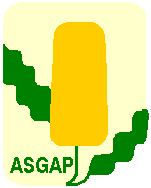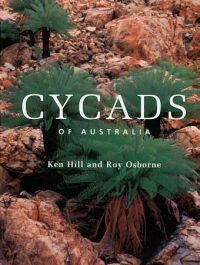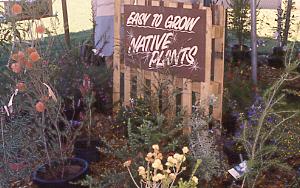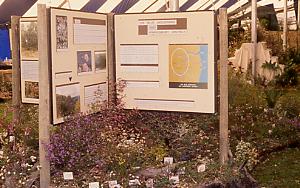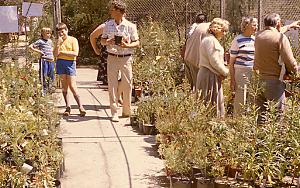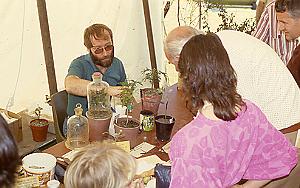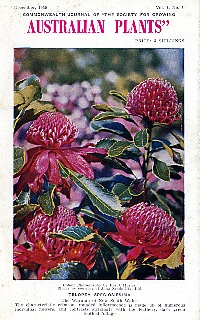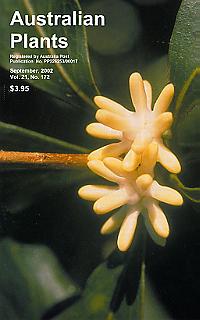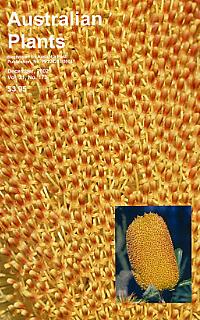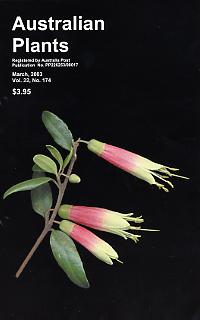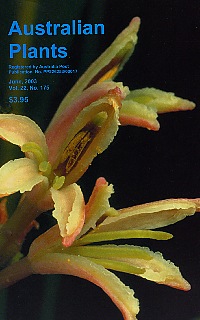 ASGAP NewsletterThe ASGAP newsletter is produced twice a year. Its main purpose is to keep member societies informed about national issues. However, it also contains material that might be of interest to individual members and others. For example, the April 2003 issue contained:
 Tribute to Bill Payne
The Australian Plants journal (December 2002) published a long tribute to Bill Payne who was its editor from September 1959 to May 2002 (over forty years). Bill is a founding member of the Society and attended the first meetings of the Society in Melbourne and Sydney. He was awarded the Society's Australian Plants Award (amateur category) in 1993. Among the many stories in the tribute and a telling one is the following: Another prime-mover in the foundation of the Society and an early officer bearer, made an honorary member of the Society at the outset, was the botanist educator and writer, Dr Thistle Harris. Her biographer, Joan Webb, writes that from the day Bill Payne accepted the position of Editor, Thistle was outspoken in her opposition to him, claiming he did not have the experience or the ability. Some years later she was to concede that Bill had produced a 'first-rate publication.' Bill played an active role in getting a number of Study Groups off the ground, promoting the establishment of the Australian Cultivar Registration Authority, and figured in a number of books. A keen photographer himself, he ensured that Australian Plants bad the best photographs, many inveigled out of the Society' best photographers. The tribute ends: "In all, Bill Payne has been a tireless worker, donating many hours of his own and family's life to the cause and promotion of the Australian flora. He is an extraordinary member in every sense." From the ASGAP Newsletter, April 2003.  No Name Change for Queensland RegionIn a recent referendum by the Queensland Region of the Society for Growing Australian Plants (SGAP), members narrowly decided to retain the current name. This means that the Queensland is the only Region to retain SGAP as its name. The New South Wales, Victorian, Tasmanian and South Australian Regions changed to Australian Plants Society some years ago and Canberra Region recently adopted Australian Native Plants Society as its name. In Western Australia, the name has always been Wildflower Society of Western Australia.  Study Group NewsWattle as an 'environmental weed'Acacia Study Group Newsletter (November 2002) has an interesting discussion on wattles as environmental weeds. In Victoria nine wattles are considered environmental weeds (naturalised foreigners), whereas around Brisbane, only two fall into this category. The Newsletter rightly points out that many wattles are planted in gardens and show no sign of becoming naturalised. Also interesting. Acacia baileyana. which is considered an environmental weed in the south, does not appear to be naturalising in Queensland. The group is interested in any horror stories of Acacia invasion. Hibiscus and Related Genera Study GroupThe Hibiscus and related genera Study Group has just been formed. Its leader, Geoff Harvey, has been part of a small group of members interested in the Malvaceae family, who have been operating informally, but who now feel they are ready to form a Study Group. They have been concentrating particularly on the Hibiscus, Alyogyne and Gossypium genera. Geoff says very little has been done with Hibiscus and at least 50 species are known in Australia, some of them with tremendous potential for cultivation, hybridizing and selection of superior clones. Geoff comes highly recommended by other members of SGAP, who are impressed by his knowledge, enthusiasm and meticulous record keeping, his willingness to travel any distance to follow up information on his chosen genera, and the collection he is building up. Epacris Study GroupThe Epacris Study Group is continuing its practice of producing very interesting newsletters with a series of detailed plant profiles of Epacris species in cultivation. Featured in the March 2003 newsletter is Epacris impressa, the most naturally widespread and commonly cultivated species. It is the floral emblem of Victoria and was widely cultivated in Britain during the nineteenth century. If this is a plant you hanker after for your garden, here is all the information you need to make an educated choice between the many named selections, varieties and cultivars. Ispogon and Petrophile Study GroupThe discovery of three new species of Petrophile is reported in the January 2003 issue of the Study Group's Newsletter. The paper by Mike Hislop and Barbara Rye of the Western Australian Herbarium that described the new species, Petrophile antecedens, P.clavata and P.brevifolia is summarised, there are full colour photographs of the species in flower, and a revised key to the Genus is provided. From the ASGAP newsletter (April 2003) and the newsletter of the Australian Native Plants Society (Canberra), September 2003.  "Australian Plants"....in print!The Society's 48 page, colour (printed) journal, "Australian Plants" has been published quarterly since 1959. It carries articles of interest to both amateur growers and professionals in botany and horticulture. Its authors include the leading professional and amateur researchers working in with the Australian flora and many beautiful and high quality photographs of Australian plants are published in its pages. Topics covered by the journal cover a wide range and include landscaping, growing, botany, propagation and conservation. A subscription to the print version of "Australian Plants" is $20 annually for 4 issues (overseas $AUS32) including postage. To subscribe, print out the Subscription Form and post or fax the appropriate fee to the address indicated on the form. Note that the contents of "Australian Plants" and "Australian Plants online" These are some of the topics covered in recent issues of "Australian Plants":
 Brian Walters [Front Page] [Features] [Departments] [Society Home] [Subscribe] Australian Plants online - September 2003 |

